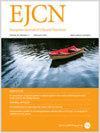日本成年人使用稳定同位素技术测量的与水消耗量相关的因素:一项横断面研究。
IF 3.3
3区 医学
Q2 NUTRITION & DIETETICS
引用次数: 0
摘要
背景/目的:虽然一些膳食指南规定了成年人的每日需水量,但老年人的需水量并没有得到很好的界定。与表示水需求量的水周转量(WT)和从食物和饮料中摄入的液体的预制水(PW)相关的因素仍然鲜为人知。因此,我们旨在调查日本成年人的这些因素:这项横断面研究包括 57 名居住在日本福冈市、年龄在 54-85 岁之间的参与者。从 2015 年 8 月到 2015 年 9 月,我们使用双标记水(DLW)方法测量了 WT 和 PW。饮食摄入量和体力活动分别使用 3 天饮食记录(DR)和经验证的三轴加速度计进行评估。空腹血液和尿液样本以及环境条件则采用验证技术进行评估。我们使用多变量广义线性模型对预测耗水量的变量进行了评估,并利用这些协变量进行了前向逐步选择:结果:WT 和 PW 的中位数分别为 2842 毫升/天和 2227 毫升/天。在多变量模型中,WT(R2 = 0.629)和PW(R2 = 0.621)在一定程度上受性别、体重、中度至剧烈运动、DR估计的耗水量、尿醛固酮和渗透压、肌酐清除率和湿球温度等变量的影响。DR估计的脉搏波速度比DLW方法估计的脉搏波速度低40%,尽管这两个值之间存在显著的相关性:WT和PW不仅与生活方式和环境因素有关,还与尿液指标和肾功能有关。结论:WT 和 PW 不仅与生活方式和环境因素有关,还与泌尿系统标志物和肾功能有关。这些发现为了解每个人对水的需求差异提供了有益的启示。本文章由计算机程序翻译,如有差异,请以英文原文为准。


Factors associated with water consumption measured using the stable isotope techniques among Japanese adults: a cross-sectional study
While some dietary guidelines have established daily water requirements for adults, those for older adults are not well defined. Factors associated with water turnover (WT), indicating water requirements and preformed water (PW), referring to fluids consumed from food and beverages, remain poorly understood. Therefore, we aimed to investigate these factors in Japanese adults. This cross-sectional study included 57 participants aged 54–85 years, living in Fukuoka City, Japan. The WT and PW were measured using the doubly labelled water (DLW) methods from August 2015 to September 2015. Dietary intake and physical activity were evaluated using a 3-day dietary record (DR) and a validated triaxial accelerometer, respectively. Fasting blood and urine samples, as well as environmental conditions, were assessed using a validated technique. We evaluated the variables for predicting water consumption by using a multivariate generalised linear model, with forward stepwise selection using these covariates. The median WT and PW were 2842 ml/day and 2227 ml/day, respectively. In the multivariate model, WT (R2 = 0.629) and PW (R2 = 0.621) were moderately predicted by variables such as sex, body weight, moderate-to-vigorous physical activity, water consumption estimated by DR, urinary aldosterone and osmolality, creatinine clearance and wet-bulb globe temperature. The PW estimates from DR were ~40% lower than those from DLW method, despite a significant correlation between the values. WT and PW are associated not only with lifestyle and environmental factors but also with urinary markers and kidney function. These findings provide useful insights into the differences in each individual’s water requirement.
求助全文
通过发布文献求助,成功后即可免费获取论文全文。
去求助
来源期刊
CiteScore
10.60
自引率
2.10%
发文量
189
审稿时长
3-6 weeks
期刊介绍:
The European Journal of Clinical Nutrition (EJCN) is an international, peer-reviewed journal covering all aspects of human and clinical nutrition. The journal welcomes original research, reviews, case reports and brief communications based on clinical, metabolic and epidemiological studies that describe methodologies, mechanisms, associations and benefits of nutritional interventions for clinical disease and health promotion.
Topics of interest include but are not limited to:
Nutrition and Health (including climate and ecological aspects)
Metabolism & Metabolomics
Genomics and personalized strategies in nutrition
Nutrition during the early life cycle
Health issues and nutrition in the elderly
Phenotyping in clinical nutrition
Nutrition in acute and chronic diseases
The double burden of ''malnutrition'': Under-nutrition and Obesity
Prevention of Non Communicable Diseases (NCD)

 求助内容:
求助内容: 应助结果提醒方式:
应助结果提醒方式:


